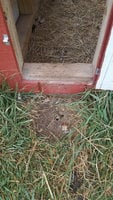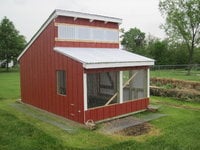First, many thanks to Jack E for posting pictures of his Woods Colony House, which is partially what convinced me this style of house was the way to go. In my opinion, one of the more interesting threads on this whole forum.
https://www.backyardchickens.com/t/445004/woods-style-house-in-the-winter
Also, many thanks to Robert P for taking it upon himself to publish and make available Wood's book on fresh air poultry houses.
http://www.amazon.com/dp/097217706X/?tag=backy-20
Anyway, once I was convinced this was the way to go, a decision had to be made on how big. Woods 10' x 16' was too big for my use and his 6' x 10' was about right, but for what seemed like the same materials, I could up that to 8' x 12', which is what I did. I also decided early on this building would be portable........more like can be moved......vs. portable in the "tractor" sense. I do plan to move it around......perhaps once a year or so, if not more often. Initially, this will be used to grow about 15 pullets, some of which are my daughters and will be heading off to her place once they feather out and don't need the heat lamps to survive. That will leave me with about 8 or 9 birds, which are the most I intend to keep. More like 6 or so most of the time, with some allowance for losses.
Anyway, this is not complete.......lots of trim work and other finish work left to do..........a screen door and monitor windows and window screens to build, but is ready for occupancy, which is a good thing, as I have those 15 - 2 week old birds that are rapidly outgrowing their brooder box and need a proper house to occupy. Weather permitting, move in day is tomorrow.
First.....a few pictures........




Again, I still have to build the monitor windows, so for now, I simply screwed the dropped scraps off the poly roofing over the monitor window openings that is over the scratch shed. Since it is getting warmer all the time, my initial thought was to simply tack some hardware cloth over the opening to keep varmints out, but that was before I rode out a cloud burst in it and saw how much rain was coming in through the open monitor windows. That was not going to work.
I would also say red is not my favorite color, but it does match the horse barn out back (came with the property).
The last photo shows some of the details that make this portable (built on 4" x 6" treated timbers for skids), and also how I went about installing the wire apron around the perimeter to keep digging predators out. That I had a really tough time finding a way to run an extension cord into the building to use for a heat lamp makes me think a predator will also have a tough time making it in. If he does, I won't be happy about it, but I would be impressed by his skill in defeating me.
For those who may be inspired by these houses.....or related somehow to someone who is and who will be tasked with trying to build one, I also plan to elaborate on the design criteria that went into building the thing. And a disclaimer.......while I own a variety of hammers, saws and tape measures, I"m not a framing or finish carpenter. Some will come up with better (and far less expensive) ways of building one of these than I did. I already have suggestions for planned changes. But that will come later, once I have some experience with growing and housing birds in the thing. I am also curious by nature, so a lot of things that went in to this were not necessary, but put in to test some things.
But so far, so good. Lets see how well it works!
https://www.backyardchickens.com/t/445004/woods-style-house-in-the-winter
Also, many thanks to Robert P for taking it upon himself to publish and make available Wood's book on fresh air poultry houses.
http://www.amazon.com/dp/097217706X/?tag=backy-20
Anyway, once I was convinced this was the way to go, a decision had to be made on how big. Woods 10' x 16' was too big for my use and his 6' x 10' was about right, but for what seemed like the same materials, I could up that to 8' x 12', which is what I did. I also decided early on this building would be portable........more like can be moved......vs. portable in the "tractor" sense. I do plan to move it around......perhaps once a year or so, if not more often. Initially, this will be used to grow about 15 pullets, some of which are my daughters and will be heading off to her place once they feather out and don't need the heat lamps to survive. That will leave me with about 8 or 9 birds, which are the most I intend to keep. More like 6 or so most of the time, with some allowance for losses.
Anyway, this is not complete.......lots of trim work and other finish work left to do..........a screen door and monitor windows and window screens to build, but is ready for occupancy, which is a good thing, as I have those 15 - 2 week old birds that are rapidly outgrowing their brooder box and need a proper house to occupy. Weather permitting, move in day is tomorrow.
First.....a few pictures........
Again, I still have to build the monitor windows, so for now, I simply screwed the dropped scraps off the poly roofing over the monitor window openings that is over the scratch shed. Since it is getting warmer all the time, my initial thought was to simply tack some hardware cloth over the opening to keep varmints out, but that was before I rode out a cloud burst in it and saw how much rain was coming in through the open monitor windows. That was not going to work.
I would also say red is not my favorite color, but it does match the horse barn out back (came with the property).
The last photo shows some of the details that make this portable (built on 4" x 6" treated timbers for skids), and also how I went about installing the wire apron around the perimeter to keep digging predators out. That I had a really tough time finding a way to run an extension cord into the building to use for a heat lamp makes me think a predator will also have a tough time making it in. If he does, I won't be happy about it, but I would be impressed by his skill in defeating me.
For those who may be inspired by these houses.....or related somehow to someone who is and who will be tasked with trying to build one, I also plan to elaborate on the design criteria that went into building the thing. And a disclaimer.......while I own a variety of hammers, saws and tape measures, I"m not a framing or finish carpenter. Some will come up with better (and far less expensive) ways of building one of these than I did. I already have suggestions for planned changes. But that will come later, once I have some experience with growing and housing birds in the thing. I am also curious by nature, so a lot of things that went in to this were not necessary, but put in to test some things.
But so far, so good. Lets see how well it works!
Last edited:




